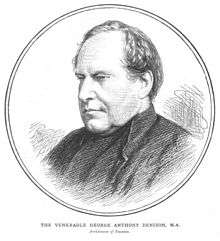George Denison (priest)
George Anthony Denison (1805–1896) was an English Anglican priest. He served as Archdeacon of Taunton from 1851.
George Denison | |
|---|---|
| Archdeacon of Taunton | |
 | |
| Church | Church of England |
| Province | Canterbury |
| Diocese | Bath and Wells |
| In office | 1851–1896 |
| Predecessor | Anthony Hamilton |
| Successor | Alexander Ainslie |
| Orders | |
| Ordination | 1832 |
| Personal details | |
| Birth name | George Anthony Denison |
| Born | 11 December 1805 Ossington, England |
| Died | 21 March 1896 (aged 90) East Brent, England |
| Denomination | Anglican |
| Parents |
|
| Spouse | Georgiana Henley ( m. 1838) |
| Alma mater | Christ Church, Oxford |
Life
Brother of politician Evelyn Denison, 1st Viscount Ossington, colonial administrator Sir William Denison and bishop Edward Denison, he was born on 11 December 1805 at Ossington, Nottinghamshire, and educated at Eton College and Christ Church, Oxford. In 1819 he was sent to Eton.[3] In 1828 he was elected fellow of Oriel College; and after a few years there as a tutor, during which he was ordained and acted as curate at Cuddesdon, he became rector of Broadwindsor, Dorset (1838). He became a prebendary of Sarum in 1841 and of Wells in 1849. In 1851 he was preferred to the valuable living of East Brent, Somerset, and in the same year was made Archdeacon of Taunton.[4]
For many years Denison represented the extreme High Tory party not only in politics but in the church, regarding all progressive movements in education or theology as abomination, and vehemently repudiating the higher criticism from the days of Essays and Reviews (1860) to those of Lux Mundi (1890).
He died on 21 March 1896 in East Brent.[5]
Ditcher v. Denison
.jpg)
On 7 August and 6 November 1853, he preached two sermons in Wells Cathedral on the real presence of Christ in the Eucharist, taking a position similar to that for which Edward Bouverie Pusey had been suspended ten years before.[3] He resigned his position as examining chaplain to the Bishop of Bath and Wells owing to his pronounced eucharistic views. A suit on the complaint of a neighbouring clergyman ensued and after various complications Denison was condemned by the archbishop's court at Bath (1856). The judgment did not pass unchallenged, and that autumn a protest was issued arguing that Denison's teaching was in conformity with the best Anglican authorities. The protest was signed by fifteen of the most prominent Anglo-Catholics of the time, including Pusey, John Keble, and J. M. Neale.[3]
On appeal the Court of Arches and the privy council quashed this judgment on a technical plea.[4]
The case was significant for the various writings on the Eucharist that followed. In 1857, before the Court of Appeals had rendered its decision, John Keble wrote one of his more important works, his treatise on eucharistic adoration, in support of Denison.[6] Pusey published his Doctrine of the Real Presence in the summer of 1857.[7]
The result was to make Denison a keen champion of the ritualistic school, although he, himself, never wore vestments. He edited The Church and State Review (1862–1865). Secular state education and the conscience clause were anathema to him. Until the end of his life he remained a protagonist in theological controversy and a keen fighter against latitudinarianism and liberalism; but the sharpest religious or political differences never broke his personal friendships and his Christian charity. Among other things for which he will be remembered was his origination of harvest festivals.[4]
References
Footnotes
- Rigg 1901, p. 127; Rigg & Herring 2004.
- "Biography of George Anthony Denison, Archdeacon of Taunton (1805–1896)". Nottingham: University of Nottingham. Retrieved 30 April 2019.
- "George Anthony Denison". London: Catholic Literature Association. 1933. Retrieved 30 April 2019 – via Project Canterbury.
- Chisholm 1911.
- Rigg & Herring 2004.
- "John Keble". London: Catholic Literature Association. 1933. Retrieved 30 April 2019 – via Project Canterbury.
- Pusey, Edward Bouverie (1855). The doctrine of the real presence as set forth in the works of divines and others of the English church since the Reformation. Oxford and London: John Henry and James Parker.
Bibliography
- Chisholm, Hugh, ed. (1911). . Encyclopædia Britannica. 8 (11th ed.). New York: Cambridge University Press. p. 22.CS1 maint: ref=harv (link)
This article incorporates text from this public-domain publication. - Rigg, J. M. (1901). . In Lee, Sidney (ed.). Dictionary of National Biography (1st supplement). 2. London: Smith, Elder & Co. pp. 127–129.CS1 maint: ref=harv (link)
- Rigg, J. M.; Herring, George (2004). "Denison, George Anthony (1805–1896)". Oxford Dictionary of National Biography (online ed.). Oxford University Press. doi:10.1093/ref:odnb/7488.CS1 maint: ref=harv (link) (Subscription or UK public library membership required.)
External links
| Church of England titles | ||
|---|---|---|
| Preceded by Anthony Hamilton |
Archdeacon of Taunton 1851–1896 |
Succeeded by Alexander Ainslie |